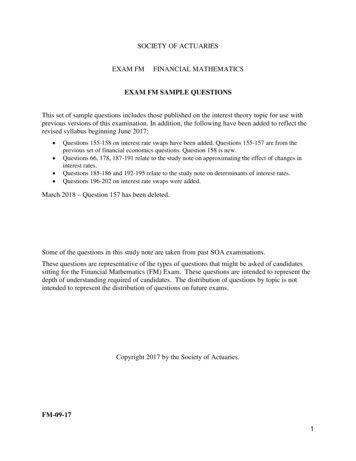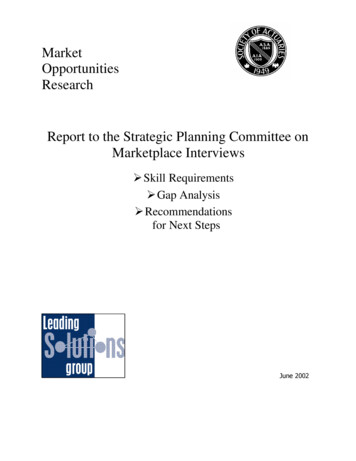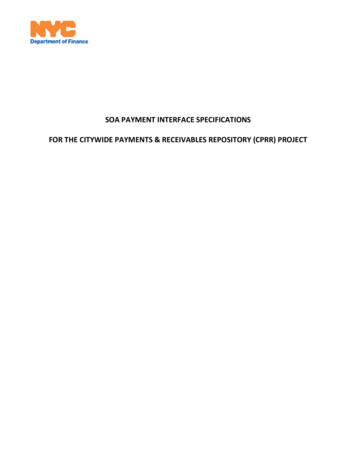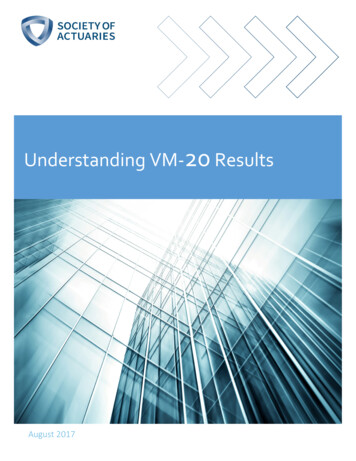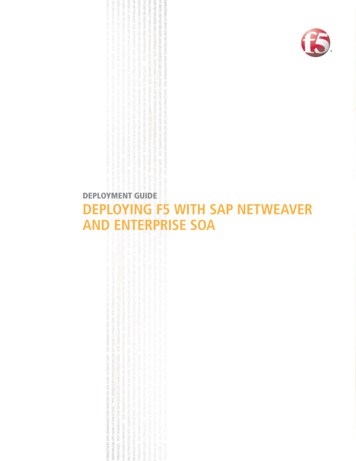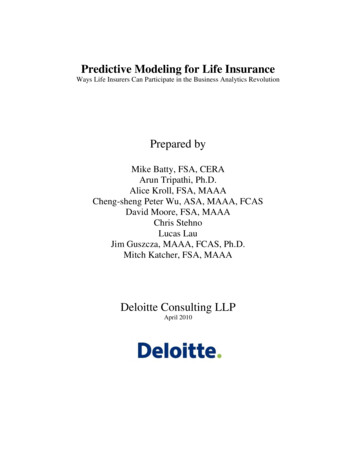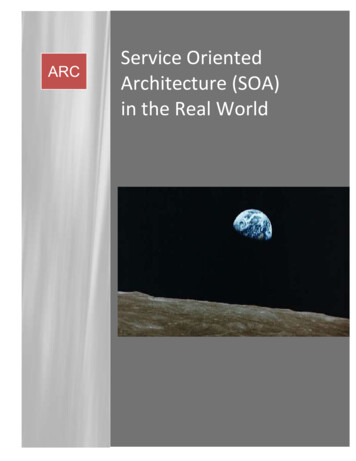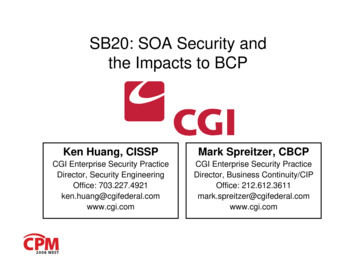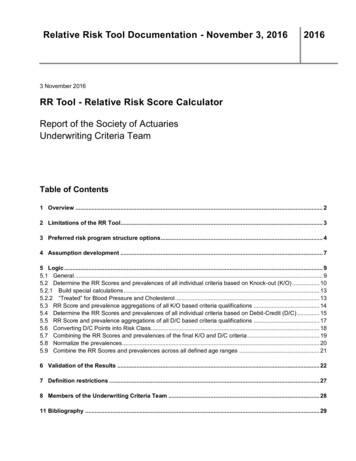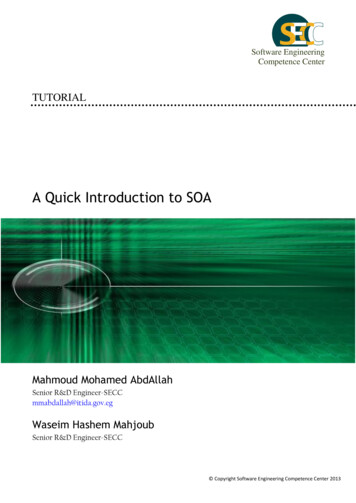
Transcription
Software EngineeringCompetence CenterTUTORIALA Quick Introduction to SOAMahmoud Mohamed AbdAllahSenior R&D Engineer-SECCmmabdallah@itida.gov.egWaseim Hashem MahjoubSenior R&D Engineer-SECC Copyright Software Engineering Competence Center 2013
AbstractAchieving business agility and easing the integration of legacy systems are maingoals for software development in various business organizations. Businessagility is the ability to change the business process quickly in response to thechange in the business environment, such as adding a new service to theorganization portfolio. One way to achieve this in a fast, yet cost effective way isto adopt the Service Oriented Architecture (SOA) approach. SOA is anarchitecture methodology that views the system as set of services. The service isa software component that implements a reasonable amount of work. Eachservice is loosely coupled to increase its scalability and reusability. So, whenevera business need emerges and requires adding new functionality to the system,the development team in the organization can develop a service that fulfill thatneed, and rapidly integrates it in the current system without the need to changethe overall architecture of the system.The aim of this tutorial is to introduce SOA and its benefits, and provide a briefoverview about the popular implementations of SOA and the concept of WebServices.Keywords: SOA, Service Oriented Architecture, Design Principles, ESB,Enterprise Service Bus, Web Service, SOAP, WSDL, UDDIA Quick Introduction to SOA TutorialPage 2
Table of Contents1.Introduction42.What is SOA?52.1.SOA components52.2.Example62.3.Design Principles of SOA72.4.Benefits of SOA3.3.1.4.Enterprise Service Bus (ESB)ESBWeb Services Approach131414164.1.Web Service Architecture164.2.Web service properties174.3.Web services standards175.Case study206.Summary227.References228.Abbreviations23A Quick Introduction to SOA TutorialPage 3
1. IntroductionA Service Oriented Architecture (SOA) is a design approach for building businessapplications as a set of loosely coupled black box components orchestrated todeliver a well-defined level of service by linking together business processes [1].As it is clear from the definition, SOA is an architectural concept which meansthat it is applied during the early design phase of the development lifecycle. Asany software concept, SOA is not suitable for all types of IT applications. Forexample SOA is not suitable for real-time applications.When using the SOA approach, business applications are viewed as set of blackbox components in order to increase the level of abstraction, and hence, ease thereuse of these components. The interaction between these components issimple; such that one component sends a request to another one, and the latterreplies back with the requested data or action.The previous components are combined into subsystems that interface witheach other or with the end user in order to deliver services of a particularbusiness value, such as check for duplicate products or calculate effects ofchange which is higher level business functions for the organization.A Quick Introduction to SOA TutorialPage 4
2. What is SOA?2.1.SOA componentsFigure 1 depicts the main components of a typical SOA-based solution.Figure 1.Main components of a typical SOA systemIn the following, we briefly define each of the components shown in Figure 1 Enterprise Service BUS (ESB): It is defined as a set of softwarecomponents that manage the message routing and transmission from onesoftware component to another. It is also responsible for translating thetransfer protocol in case of using different transfer protocols in thecommunicating software components.SOA Registry: It keeps information about each service functionality andlocation.Service Broker: It is responsible for connecting the requester of theservice to the provider of the service with the help of the SOA Registryand SOA Service Manager. Instead of hard coding the address of theservice, the requester will communicate with the broker, and then thebroker will make the connection between the requester and the provideraccording to the settled rules.SOA Service Manager: It ensures the quality of the services in the SOAarchitecture.Business Process Orchestration Manager: Set of tools to help the systemto connect: people to people people to processes processes to processesA Quick Introduction to SOA TutorialPage 5
cationCRMApplicationNewFunctionalityServerCustomer DataMarketingManagmentBankingServersFigure 2. System design using the conventional design approachTo demonstrate the idea of using SOA, we consider the following simpleexample. The conventional design approach is first explained, then the SOAbased design approach is discussed. Company X is working in the field ofinsurance. It owns a legacy system (Figure 2) that enables companyemployees to view and edit customer data and calculate various ratesaccording to the customer requests. Due to company expansion and businessneed for offering new services to the customers, the IT department must adda new functionality to the System. Accordingly, The IT development team hasupgraded the system and found that they should retest the whole system tomake sure that’s the original functionalities are still functioning normally.In this case, the development team will need to retest both the old and thenew added functionalities.If the company has have used the SOA approach , the development teamwould have viewed the system as set of services including the oldfunctionalities and the new proposed functionality, as shown in Figure 3.A Quick Introduction to SOA TutorialPage 6
plicationNewFunctionalityESBServerCustomer DataMarketingManagmentBankingServersFigure 3. System design using the SOA approachAs shown in the figure, the system uses ESB, service registry, and the legacysystem is wrapped up with communication interface in order to connect tothe ESB. Now, the new service can be developed and linked to the ESBwithout the need to know the internals of the legacy system. Also, a set ofreusable data services is developed in order to access the data servers andmake the CRUD functions. These services will be used by the old system aswell as any new developed services.In this new design, testing can be done on the new services and the interfacepart only of the old components.2.3.Design Principles of SOAThe core of the SOA approach is to have various units of solution logicrepresented and exposed as services. This necessitates the development ofpractices and standards in order to help software developers to identifydesigns and design services.SOA design principles are generalized, accepted industry practices forproviding rules and guidelines that determine exactly how solution logicshould be decomposed and shaped into software services. So, the consistentapplication of service-orientation design principles leads to the creation ofservices with functional contexts that are agnostic to any business process orapplication. These agnostic services are therefore capable of participating inmultiple service compositions achieving the ultimate goal of SOA [4].A Quick Introduction to SOA TutorialPage 7
The service-orientation paradigm advocates the following nine distinctdesign principles, each of which supports fundamental design characteristicsthat form the target solution logic as service oriented[5].The following is a brief description of each principle accompanied with anillustrating figure [3]: Principle 1: Standardized service contractAll service description, purpose, communication protocol, and messageformat should be documented in a service contract. In order to make allclients understand this contract, it should be written in a standard-basedservice description format as demonstrated in Figure 4.Figure 4. Standardized Service Contract Principle Principle 2: Loose couplingLoose coupling emphasizes that services should be designed to haveminimal dependencies on each other by achieving logical separation ofconcerns. The services shouldn’t be tightly- coupled as demonstrated inFigure 5. Different layers of loose coupling should be achieved whiledesigning services, starting from the service contract, ending with serviceimplementation. For example, when the service provider is changed orremoved, this will require changing the service consumer. So, it is betterto keep these dependencies to minimum in order to reduce the requiredchanges when an upgrade in the system is needed.A Quick Introduction to SOA TutorialPage 8
Figure 5. Loose Coupling Principle Principle 3: Service abstractionServices encapsulate the logic they provide from the outside worldavoiding the proliferation of unnecessary service information internalimplementation, technology, logic, and function away from users of theservices as shown in Figure 6. This helps greatly in developing applicationswithout the need to review, and analyze unimportant details about thesystem.Figure 6. Service Abstraction Principle Principle 4: Service reusabilityReusability implies that the solution logic is divided into services with theintent of maximizing reuse. The services must contain and expressagnostic logic and can be positioned as reusable enterprise resources.Service reusability represents a design principle that should beconsidered during service design as well as an imperative goal of SOA.Figure 7 illustrates the idea of service reuse by comparing the design oftwo applications required to provide the same functionality at the presenttime. But reusability requires special consideration to balance therequired developing effort and time with the benefits to be achieved inA Quick Introduction to SOA TutorialPage 9
the future. For example, separating a service like calculate taxes as standalone service and reusing it in the application will add a clear overhead inthe time needed for the service design and development. However, on theother hand, when the rules and regulations of taxes changes over time, theonly place that requires upgrade is the “calculate taxes” service.Figure 7. Service Reusability Principle Principle 5: Service autonomyThis principle ensures that the service benefit is acquired only by theservice implementation, and thus, no service is controlled by anotherservice as demonstrated in Figure 8. Two primary benefits are achievedwhen applying service autonomy; system reliability and behaviorpredictability.Figure 8. Service Autonomy PrincipleA Quick Introduction to SOA TutorialPage 10
Principle 6: Service statelessnessIn distributed architectures, it is important to keep track of theinteractions history between the server and client parts of the system.However, to make the architecture scalable (i.e. can reliably support largenumber of requests), it is a good practice to follow the ServiceStatelessness principle.Service statelessness suggests differing state information as much aspossible in order to minimize resource consumption. As shown in Figure 9,service statelessness encourages incorporating state managementdeferral approach within service designs so as to keep services in astateless condition wherever appropriate. For example, this can be doneusing a separate component which keeps track of the states of the services(e.g. storing session data in a database)Figure 9. Service Statelessness Principle Principle 7: Service discoverabilityApplications should learn about the services of the system in a systematicway. This service discoverability principle implies two requirements: (1)service contracts are equipped with appropriate metadata, and (2) aservice registry exists in order to store the service description records asshown in Figure 10.A Quick Introduction to SOA TutorialPage 11
Figure 10. Service Discoverability Principle Principle 8: Service composabilityServices are designed as reusable units that can be reconfigured easily toreflect new requirements and business processes, and thus, can be used indifferent applications. This principle affects directly the business agility.So any application will be composed of any number of services as shownin Figure 11.Figure 11. Service Composability Principle Principle 9: Service interoperabilityIn many real applications, it is possible that the service consumer runs ona different platform other than that of the service provider. In this case, itwill be difficult for them to interact unless they both agree on the samestandard for interaction. Service interoperability necessitates the usage ofstandards that allow diverse subscribers to use the service. Thus, a specialcare should be given to the used transport protocols and message formatsA Quick Introduction to SOA TutorialPage 12
while designing the services to enable various types of clients (e.g. webbrowsers, desktop front-end ,etc.) to use these services as shown inFigure 12.Figure 12. Service Interoperability Principle2.4.Benefits of SOAThe increasing complexity of business processes and systems coupled with therapid changes in market needs and business requirements; and agility, flexibility,and business automation have became vital for enterprises to survive [4]. SOA isa strong candidate paradigm for the realization of the agility, flexibility, andautomation of the business processes that span large distributed systems. It is anapproach that can support systems to remain scalable and flexible whilegrowing. Companies that need customizable solutions or use IT for competitivevalue, companies seeking to leverage IT capabilities for business advantage,these are companies that should care about SOA. The SOA supports therealization of these strategic goals ,that enables business and IT to collaborate inorder to achieve: Greater flexibility in strategic applications Faster time to value from IT Modernized strategic applications Lower the lifetime cost of applications or infrastructure Reuse as a goal to bring products or capabilities to the market fasterSOA provides the potential to elevate the responsiveness and cost-effectivenessof IT through a design paradigm that emphasizes the realization of strategicgoals and benefits. Figure 13 presents SOA benefits at technical and businessdimensions.A Quick Introduction to SOA TutorialPage 13
Figure 13. SOA Benefits at Technical and Business Dimensions3. Enterprise Service Bus (ESB)3.1.ESBEnterprise service bus (ESB) represents the core infrastructure of any SOAimplementation. Enterprises commonly deploy diverse applications, platforms,and business processes communicating to each other using incompatible dataformats and communications protocols. Accordingly, ESB simplifies thecomplexity of integration by providing a single, standards-based infrastructureinto which applications can be plugged as demonstrated in Figure 14. Onceplugged into the ESB, an application or service has access to the entireinfrastructure services like data transformation, transport mediation and othersprovided by the ESB. Moreover, the application can access any other applicationthat are also plugged into the ESB. For instance, one could plug a billing systembased on JMS into an ESB and use the ESBs transport mediation features toexpose the billing system over the Web using SOAP/HTTP. You could also routeinternal purchase orders directly into the billing system by plugging thePurchase Order system into the ESB [5].A Quick Introduction to SOA TutorialPage 14
.Figure 14. ESB InfrastructureTo run SOA in practice, one need a way for calling services. ESB is mainly a groupof applications that provides various intermediation services for the enterpriseapplications to be able to call and talk to each other. The service provided byeach ESB varies from one to another depending on the complexity, scalability,and the cost of the final solution. Commonly, the following are the main servicesand functionalities that are provided by an ESB: Data transformation: Applications are using different data formats andmessage structures to represent real world concepts. Thus, ESB comes asan intermediary that translates from one format to another supportingdifferent formats and message structures allows greater flexibility andscalability for the target solution. Transport mediation: Various transportation protocols are used inenterprise applications, and hence, integrating such applications requiresefficient mediation between various transportation protocols. Intelligent routing: In order to achieve achieving scalable self-functioningsolution, the system must have the capability to route messages based ontheir contents and priorities, while achieving load balancing betweenseveral service providers. This feature requires the ESB to have somesemantic understanding of at least some parts of the services. Security: only authorized and authenticated service users for a certainservice are capable for consuming that service. Also, messages thatcontain sensitive information may need to be encrypted at runtime.A Quick Introduction to SOA TutorialPage 15
In addition to the previous main features, ESBs usually provide add-on services,such as: real-time monitoring, logging, service management, hot deployment,service replications, and testing services.4. Web Services ApproachWeb services are one of the common used approaches to realize the concept ofSOA. One definition of web services is [8]: “A self-contained, modularapplications that can be described, published, located, and invoked over anetwork”.Web services can execute different sized business functions e.g., simple datarequests or wrapping legacy system to make them network enabled. It can alsocall other web services to achieve certain business function. These web serviceswill be called by the frontend application in order to achieve specific functions tothe user.4.1.Web Service ArchitectureFigure 15 demonstrates the architecture of a solution based on web serviceapproach.Figure 15. Web service generic architectureThe main components shown in Figure 16 are as follow: Service provider: is the component that implements the web service andinforms its existence to other requester by publishing its interface andaccess information in the service registry.A Quick Introduction to SOA TutorialPage 16
4.2.Service broker (registry): is responsible for the availability of bothinterface and implementation access information for the Web service toany service requester.Service requester: searches the service within the service broker to findits service provider then connect to the latter using specificcommunication protocol.Web service propertiesThe key properties that characterize the web services could be summarized asfollow: Standardization: Web services depend on mature and well knownstandards. Exposure: Web services depend on well known standard like SOAP,WSDL, and UDDI, which allow them to make use of the existinginfrastructure to be invoked across the Web. Modularity: Web service functionality can be implemented using smallerweb services in order to increase their reusability of the web services. Interoperability: The service provider and the service requester could bedeveloped using different languages on different machines. They can alsorun on different platforms.4.3.Web services standardsThe following are the core standards in implementing web services. Otherstandards exist that address web service security, web service management andothers. SOAP: (Simple Object Access Protocol) is the standard format for themessages between the web service architecture components. As shown inFigure 17, it is based on XML (Extensible Markup Language), and it isindependent of programming languages.A Quick Introduction to SOA TutorialPage 17
Figure 17. SOAP message format WSDL: Web Services Description Language is also based on XML and itdescribes the im
A Service Oriented Architecture (SOA) is a design approach for building business applications as a set of loosely coupled black box components orchestrated to deliver a well-defined level of service by linking together business processes [1].

